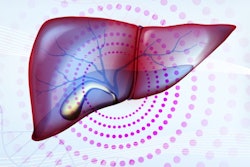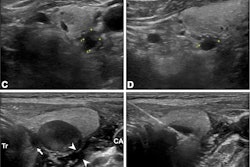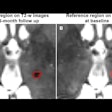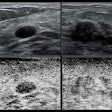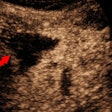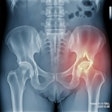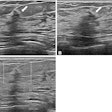Microwave ablation (MWA) with ultrasound has moderate efficacy in treating patients with benign nodules and papillary thyroid carcinoma, suggest results published August 22 in Ultrasound in Biology & Medicine.
In a three-year study, researchers led by Xiaoling Yu, MD, from First Medical Center of Chinese PLA General Hospital in Beijing reported high complete remission rates and no serious complications or disease progression in patients who underwent MWA.
“MWA is a safe and effective treatment option for hyperthyroidism with benign nodules or papillary thyroid carcinoma,” Yu and colleagues wrote.
Current standard treatment methods for hyperthyroidism with nodules include antithyroid drugs, radioactive iodine therapy, and surgical resection. However, each has its drawbacks, including invasiveness, limited effectiveness, and post-treatment complications.
MWA under ultrasound guidance has emerged in recent years as a potential alternative treatment that supporters say is minimally invasive, safe, and effective at treating lesions.
The Yu team compared the three-year efficacy and safety outcomes of MWA in treating hyperthyroidism with benign nodules and patients with thyroid cancer.
The retrospective study included 66 patients with hyperthyroidism accompanied by nodules. The patients underwent MWA treatment between 2009 and 2024, and the researchers conducted a three-year follow-up after treatment to monitor indicators such as the complete remission rate of hyperthyroidism and the tumor disappearance rate.
They also used propensity score matching to analyze differences in therapeutic effects between benign nodule and cancer patient groups.
After propensity score matching, the team reported the following findings:
After three years, the complete remission rate of hyperthyroidism in the benign nodule group was 93.8% and 62.5% in the cancer group (p = 0.083).
The tumor disappearance rate in the benign nodule group was 50% and 18.8% in the cancer group (p = 0.0627).
The researchers observed no disease progression and no serious complications in either group of patients.
While the differences between the groups were not statistically significant, the researchers highlighted that the results point toward MWA’s “good effect” on improving hyperthyroidism in patients.
“MWA may indirectly regulate hyperthyroidism by reducing the functional thyroid volume, and its mechanism is similar to that of simple ablation of hyperthyroidism,” the investigators suggested.
They called for multicenter, prospective, randomized controlled studies with large sample sizes to extend the follow-up period and verify MWA’s long-term efficacy and safety profile.
The full study can be found here.





